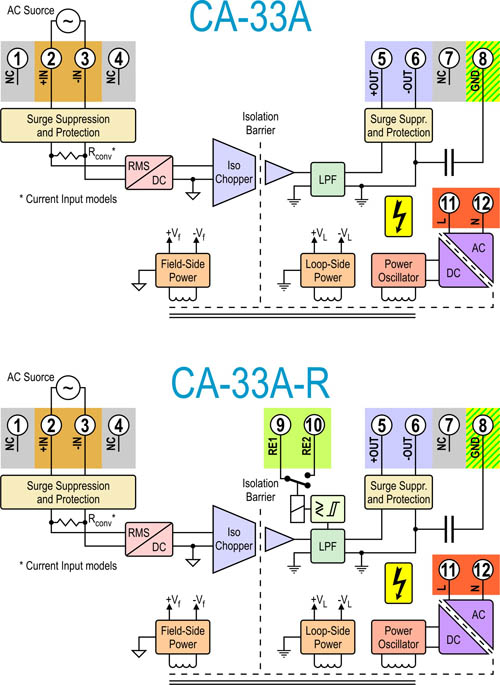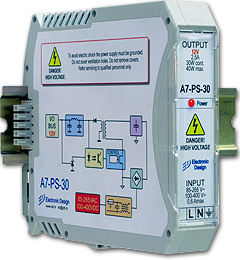![]()
|
CA 33 RMS to DC conditioners |
|
||||||||||||||||||||||||||||||||||||||||||||||||||||||||||||||||||||||||||
Attributes
|
Simplified diagram of CA-33 |
The voltage or current input signal is processed through a pre-amplifier and an RMS / DC converter. Then the voltage is measured by a chopper differential amplifier with low temperature drift, low offset and very stable gain coefficient. On the front of the module below the mask there are two multi-port trimmers for precise adjustment of the offset and the zero. Both values are factory-set and the user can override them if there is a need for it.
The central component of the module is a signal isolation transformer. Like most transformers, this has a primary and secondary side. Using this terminology, the input side of the module is the "primary side" and the output side of the module is called the "secondary side". A sensor connector is connected to the primary side of the module, and the secondary side of the module is connected to the data acquisition and measurement system, to the analog input module of the Industrial PC or PLC, to a panel meter or to another measurement system.
Transformer signal isolation uses a method of amplitude modulation to obtain linear, stable and reliable characteristics. This technique provides better results than the technique with digital or linear opto-scanners or a condenser isolation technique. The primary side of the module is galvanically isolated or "floating" in relation to the secondary side of the module and in relation to the el. power supply. The signal demodulator on the secondary side of the module restores the original signal, which is then filtered and buffered to achieve a low noise level and low impedance output signal.
The CA-33 Series Insulation Modules have a fifth-order filter built-in, with the first Anti-Aliasing pole located in the primary module circle while the fourth-row filter is located on the secondary side of the isolation barrier. After the Anti-aliasing filtering, the signal is fed to the chopper level behind the specially designed micro transformer. In the secondary stage behind the isolation barrier, the signal is demodulated and filtered again from the transmission solder and interference. The output from the module can be, if necessary, a voltage or current signal.
The warranty period is 7 years and the service period is 10 years. It
comes with a user manual in Serbian and with a calibration list.
The basic version of the CA-33 works with a standard DC power supply of 19 to 30V DC (24V DC nominal). However, if the application requires the power supply of a 220V AC coder, which is not a rare case, then the user can order a conditioner with the suffix A.
This type of conditioner works with an alternating voltage of 85 to 265V or with a DC voltage of 100 to 400V. These two power ranges make the CA-33 applicable in many situations. Some users use these conditioners in an environment that is powered by a 110V battery, or in elevated AC voltage conditions.
On this conditioning model, there are three terminals for connecting the power supply: L, N and GND (Picture on the left). The L should connect the phase, to N, and to the GND ground. Grounding, apart from the safety function, has the function of reducing the internal voltage unit oscillations, so it should be connected in any case. If the DC power supply is used, it must be connected to the L and N connectors (the schedule is not relevant).
The isolation conditioner family CA-33 with the suffix R has a relay with a working and quiet contact on the external terminals. The relay can switch on or off to 240V, 6A, and can be set to activate when the input size is greater than the specified value or when the input size is less than the set value. There is a working and quiet contact on the copies. The relay has a built-in hysteresis control that can be fine tuned with a precision multi-port trimmer potentiometer.
The only limitation for this version is that if it is used with 220V power supply (version with suffix A), the relay has only a working contact.
The setting of the relay activation level is performed by the potentiometer on the front of the conditioner. In order to avoid the oscillation of the relay when the input size is the same, the hysteresis is assigned to the device. Hysteresis in the first case, when the relay is activated and when the input is greater than the set value, indicates the size of how much the input size should be smaller than the specified relay activation size for it to be turned off. In the second case, it indicates how much the input size should be to be higher than the set to switch off the relay. Hysteresis can be set to 1% or 5% span with an internal jumper.
If the load is applied to the relay of the inductive character, it is necessary to add the "snubber" from the outside in parallel to the relay contacts. The values of the supply components are calculated, but can also be determined empirically for the given application. Generally, even if the load is applied to the relay of the inductive type, a capacitor of 0.2 uF per line with a 10 Ohm resistor can be used. For optimum performance, the supply wheel must be calculated because this is the best way to optimally extinguish the spark at the relay.
 For the power supply of a smaller number of conditioners up to
20, a CS-24-48 that delivers 48W is recommended (picture on the
left), and for greater number of conditioners a CS-24-90 of 90W should
be used. Both models can, via the T-BUS connector be
connected, directly, without wiring to power the conditioners on
the same, or with the extension cable, on different DIN rails in
a closed environment. This option raises reliability, greatly
reduces the time of replacement of the conditioner and allows
the conditioner to be connected or disconnected while the T-BUS
is powered up.
For the power supply of a smaller number of conditioners up to
20, a CS-24-48 that delivers 48W is recommended (picture on the
left), and for greater number of conditioners a CS-24-90 of 90W should
be used. Both models can, via the T-BUS connector be
connected, directly, without wiring to power the conditioners on
the same, or with the extension cable, on different DIN rails in
a closed environment. This option raises reliability, greatly
reduces the time of replacement of the conditioner and allows
the conditioner to be connected or disconnected while the T-BUS
is powered up.
Both power supplies work in a wide voltage range: CS-24-90 from
160V to 265V AC, while smaller, CS-24-48 can operate as much as
85V to 265V. If users do not want to use this type of power
supply, they can also use other power supplies, but in this
case, the power supply must be wired from one conditioner to the
other by cables.
Picture on the left: Power supply CS-24-48 for conditioners with T-BUS connector
|
The printed circuit board of the conditioner on request can be protected with special lacquer which protects electronic components from moisture, corrosion and other types of contamination, which can significantly extend the life of this product and in terms of long-term measurement accuracy. When conditioner is prepared in this way it can be applied in many aggressive environments. For example: on ships or on the seashore, in conditions of aggressive vapors, and other places with high humidity, etc... |
Typical (25°C)
| Parameter | CA-33 |
|
Input |
|
| Input voltage range | 100 mV to 300 Vrms |
| Input current range | 0 to 10 Arms |
| Input frequency range | 45 Hz do 1 kHz |
| Input impedance - voltage input | 65kΩ ÷ 1MΩ |
| Input impedance - current input | 0,01Ω |
| Input protection - voltage input | 500 V peak AC + DC max. |
| Input protection - transients | ANSI/IEEE C37.90.1- 1989 |
|
Output |
|
| Short-ciruit protection | Continuous |
| Current limit (Iout max.) | 5 mA (Vout), 30 mA (Iout) |
| Rise Time, 10% to 90% of span | < 400 ms |
| Transient protection | ANSI/IEEE C37.90.1- 1989 |
| Adjustment range | ±1,5% offset and ±5% gain (span) - typ. |
|
Accuracy |
|
| Accuracy | ±0.25% total error from 50 Hz to 1 kHz and >1% span |
| Linearity | ±0.03% |
| Temperature coefficient | 60 ppm/°C |
| Isolation | |
| CMV, Out-power | 1000 V |
| CMV, In-Out, In-power | 1500 V (4 kV 1 minute) |
| CMR 50Hz | 110 dB |
| Power supply | |
| Voltage | Od 19 V do 30 V DC |
| Current consumption | 60 mA (Vout) or 80 mA (Iout) |
| Reverse polarity protection | Continuous |
| Transient protection | ANSI/IEEE C37.90.1- 1989 |
| Environment and dimensions | |
| Temperature range (specifications) | -25 +80°C |
| Working temperature range | -40 +85°C |
| Storage temperature range | -40 +85°C |
| Humidity | Non-condensing 0 do 95% |
| Mounting rail DIN EN50022 | -35 x 7,5; -35 x 15 |
| Dimensions (mm) | 114,5 x 22,5 x 99 |
|
© 1982 -
Electronic Design Makenzijeva bb-Pejton, Beograd |
Tel: +381 11 308 50 30 Fax: +381 11 308 50 31 |
Tel: 011 2 450 480 Tel: 011 308 74 59 |
|